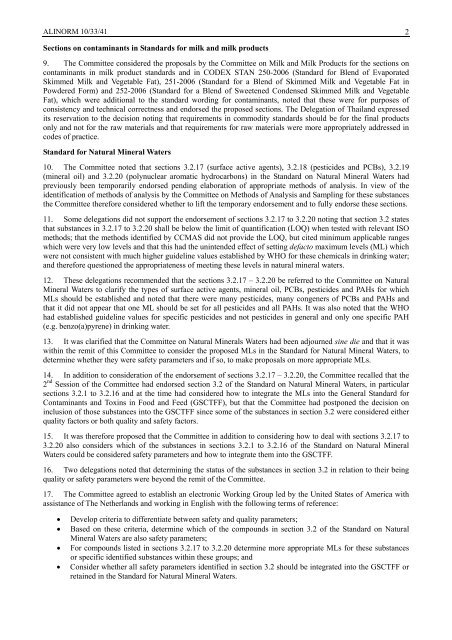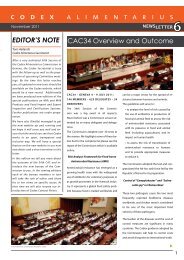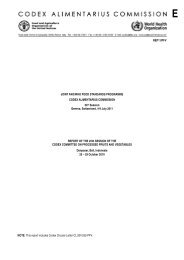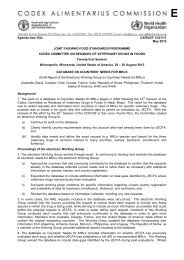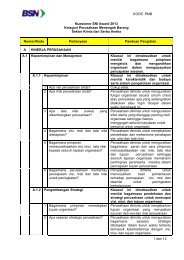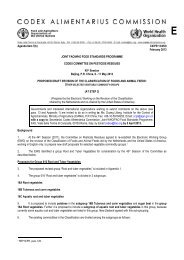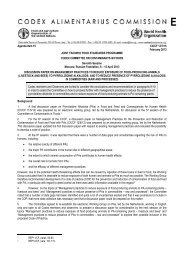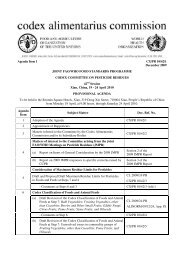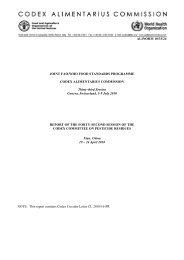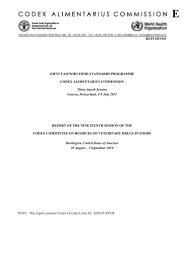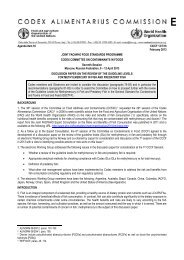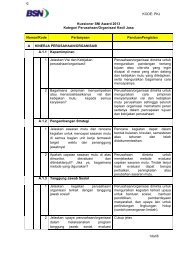alinorm 10/33/41 - CODEX Alimentarius
alinorm 10/33/41 - CODEX Alimentarius
alinorm 10/33/41 - CODEX Alimentarius
Create successful ePaper yourself
Turn your PDF publications into a flip-book with our unique Google optimized e-Paper software.
ALINORM <strong>10</strong>/<strong>33</strong>/<strong>41</strong> 2Sections on contaminants in Standards for milk and milk products9. The Committee considered the proposals by the Committee on Milk and Milk Products for the sections oncontaminants in milk product standards and in <strong>CODEX</strong> STAN 250-2006 (Standard for Blend of EvaporatedSkimmed Milk and Vegetable Fat), 251-2006 (Standard for a Blend of Skimmed Milk and Vegetable Fat inPowdered Form) and 252-2006 (Standard for a Blend of Sweetened Condensed Skimmed Milk and VegetableFat), which were additional to the standard wording for contaminants, noted that these were for purposes ofconsistency and technical correctness and endorsed the proposed sections. The Delegation of Thailand expressedits reservation to the decision noting that requirements in commodity standards should be for the final productsonly and not for the raw materials and that requirements for raw materials were more appropriately addressed incodes of practice.Standard for Natural Mineral Waters<strong>10</strong>. The Committee noted that sections 3.2.17 (surface active agents), 3.2.18 (pesticides and PCBs), 3.2.19(mineral oil) and 3.2.20 (polynuclear aromatic hydrocarbons) in the Standard on Natural Mineral Waters hadpreviously been temporarily endorsed pending elaboration of appropriate methods of analysis. In view of theidentification of methods of analysis by the Committee on Methods of Analysis and Sampling for these substancesthe Committee therefore considered whether to lift the temporary endorsement and to fully endorse these sections.11. Some delegations did not support the endorsement of sections 3.2.17 to 3.2.20 noting that section 3.2 statesthat substances in 3.2.17 to 3.2.20 shall be below the limit of quantification (LOQ) when tested with relevant ISOmethods; that the methods identified by CCMAS did not provide the LOQ, but cited minimum applicable rangeswhich were very low levels and that this had the unintended effect of setting defacto maximum levels (ML) whichwere not consistent with much higher guideline values established by WHO for these chemicals in drinking water;and therefore questioned the appropriateness of meeting these levels in natural mineral waters.12. These delegations recommended that the sections 3.2.17 – 3.2.20 be referred to the Committee on NaturalMineral Waters to clarify the types of surface active agents, mineral oil, PCBs, pesticides and PAHs for whichMLs should be established and noted that there were many pesticides, many congeners of PCBs and PAHs andthat it did not appear that one ML should be set for all pesticides and all PAHs. It was also noted that the WHOhad established guideline values for specific pesticides and not pesticides in general and only one specific PAH(e.g. benzo(a)pyrene) in drinking water.13. It was clarified that the Committee on Natural Minerals Waters had been adjourned sine die and that it waswithin the remit of this Committee to consider the proposed MLs in the Standard for Natural Mineral Waters, todetermine whether they were safety parameters and if so, to make proposals on more appropriate MLs.14. In addition to consideration of the endorsement of sections 3.2.17 – 3.2.20, the Committee recalled that the2 nd Session of the Committee had endorsed section 3.2 of the Standard on Natural Mineral Waters, in particularsections 3.2.1 to 3.2.16 and at the time had considered how to integrate the MLs into the General Standard forContaminants and Toxins in Food and Feed (GSCTFF), but that the Committee had postponed the decision oninclusion of those substances into the GSCTFF since some of the substances in section 3.2 were considered eitherquality factors or both quality and safety factors.15. It was therefore proposed that the Committee in addition to considering how to deal with sections 3.2.17 to3.2.20 also considers which of the substances in sections 3.2.1 to 3.2.16 of the Standard on Natural MineralWaters could be considered safety parameters and how to integrate them into the GSCTFF.16. Two delegations noted that determining the status of the substances in section 3.2 in relation to their beingquality or safety parameters were beyond the remit of the Committee.17. The Committee agreed to establish an electronic Working Group led by the United States of America withassistance of The Netherlands and working in English with the following terms of reference:• Develop criteria to differentiate between safety and quality parameters;• Based on these criteria, determine which of the compounds in section 3.2 of the Standard on NaturalMineral Waters are also safety parameters;• For compounds listed in sections 3.2.17 to 3.2.20 determine more appropriate MLs for these substancesor specific identified substances within these groups; and• Consider whether all safety parameters identified in section 3.2 should be integrated into the GSCTFF orretained in the Standard for Natural Mineral Waters.


